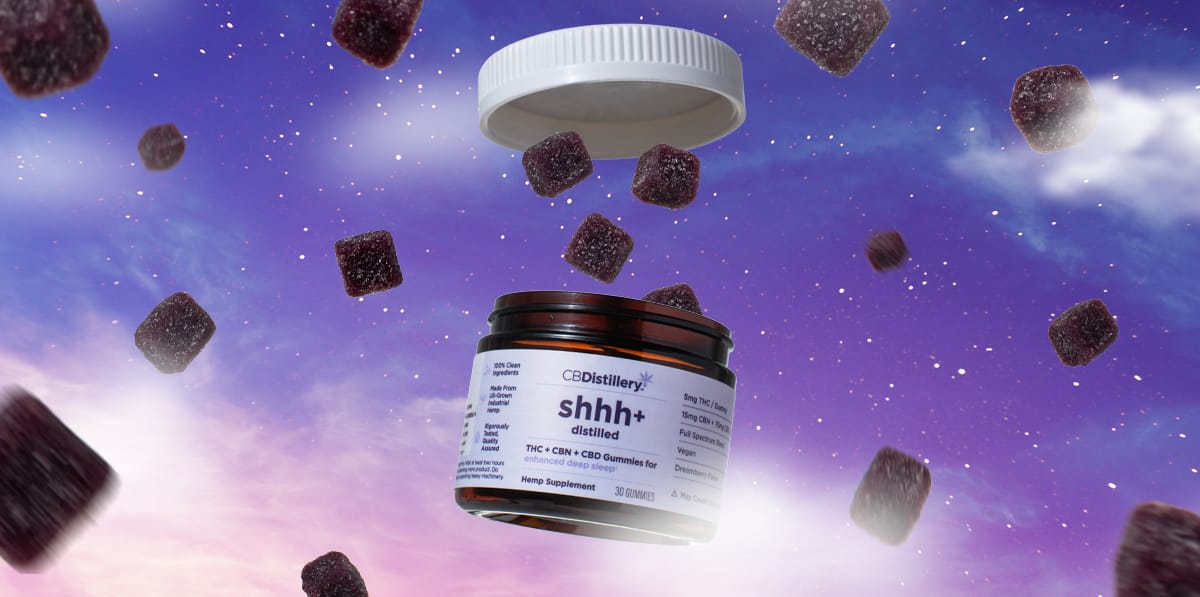- The Football Behavior Guide
- Posts
- TNF Behavior Guide Week 10
TNF Behavior Guide Week 10
Behavior Trends and Best Bets

Table of Contents

These Gummies May Result in Better Days and Deeper Sleeps
Whether it’s from a too-long to-do list or a mind that won’t shut off, a lot of people have trouble getting enough quality sleep. But many common sleep solutions can leave you feeling groggy well into the next day.
That’s why you need CBDistillery’s expert botanist formulated Enhanced Deep Sleep Gummies. With 5mg of naturally-occurring, hemp-derived Delta-9 THC, 15mg of CBN (a hemp compound known to promote sleep), and 75mg of CBD, Enhanced Sleep Gummies help you find better sleep naturally without the next-morning grogginess.
And there’s no need to wait for Black Friday; CBDistillery’s holiday savings start now! Use code BFCM30 to save 30% on your first order and join the thousands of people sleeping better with CBDistillery’s sleep gummies – just in time for the holidays that always tend to make that to-do list even longer.
What We’re Tracking:
🏈The Trend We’re Watching:Time of Possession
Broncos trends on Offense match perfectly to what we are seeing out of the Raiders on Defense.
Behavioral Trends
The Trends Matchups For Each Side of The Ball
Broncos scoring vs Raiders Score Prevention
Time of Possession
How this leads to a 28-20 Broncos Victory
Narrative Analysis
This matchup profiles like a classic “steady separation” game for Denver. On offense, the Broncos’ SBx sits at 0.798 pts/min (cel ×1.18)—a clean, upward trend in finishing—meeting a Raiders defense allowing 0.727 pts/min (SPBx, cel ×1.04). That pairing says Denver can sustain normal pace and still finish above par, especially if they keep early downs on schedule and avoid low-red penalties. Put simply: Denver doesn’t need gimmicks to score; they need to cash routine red-zone trips.

The possession math quietly tilts to the Broncos’ script. Denver’s offensive ball-possession rate is 0.0339 → ~29:30 TOP, while Las Vegas’ prevention profile has opponents sitting at 0.03142 → ~31:50 TOP (cel ÷1.28)—opponents’ drives are getting longer against the Raiders. That’s a sweet spot for the Broncos’ multi-first-down offense: more snaps, fewer coin-flip moments, and a higher chance that one drive per half turns seven instead of three. If Denver stacks two 10+ play drives, they can own the middle eight and shape field position the rest of the night.
On the other side, the Raiders’ SBx is 0.550 (cel ×1.38)—a legit surge in finishing—banging into a Denver defense allowing 0.520 pts/min (SPBx, cel ×1.13). The base rates are tight, but the “how” matters: Denver’s ball-possession prevention holds opponents near ~29:51 TOP, while Las Vegas’ own possession sits around ~30:18 (rate 0.0330, cel ×1.05). That near-wash by time puts the hinge on efficiency rather than volume; if the Broncos force two low-red stalls (or one turnover on a drive in plus territory), the Raiders’ recent celeration bump gets muted on the scoreboard.

The behavioral levers to watch are simple and stark. Explosives vs. low-red: Las Vegas needs two explosives (or a short field) to compensate for Denver’s finishing edge, while the Broncos need to avoid the kind of negative first-down plays that turn 7s into 3s. Hidden yards will tell on the margin—coverage units and penalty discipline, especially on punt-return exchanges, can be an invisible four-point swing. If the game stays clean, Denver’s higher SBx plus possession control is built to slowly widen the gap.
Netting it out, the model’s shape matches our “most likely outcome” projection: Broncos 28, Raiders 20.
Denver’s offense is trending up into a Raider defense that’s asking for longer and longer series, while the Broncos’ defense has just enough stuffing power to trade one Raiders touchdown for two field goals. If Las Vegas wins takeaways and hits a deep shot, it can narrow late—but absent that, this is Denver’s kind of game.
Behavioral Analytics Breakdown
Broncos offense (SBx) vs. Raiders defense (SPBx: “Points Given Up Per Game”)

DEN SBx: 0.798 pts/min with celeration x1.18 (finishing is trending upward).
LV SPBx: 0.727 pts/min allowed with celeration x1.04 (slightly worsening prevention—allowing scores a bit faster week over week).
Read: At baseline, Denver finishes drives faster than the rate Las Vegas prevents them, and the trend favors Denver: rising Bronco SBx vs. a gently loosening Raider SPBx. That combination supports something near ~28 points if Denver avoids self-inflicted stalls (penalties/low-red bog-downs).
Broncos SPBx vs Raiders SBx

DEN SPBx: 0.520 pts/min allowed, celeration x1.13 (defense has loosened a touch—still a good base rate).
LV SBx: 0.550 pts/min, celeration x1.38 (Raiders’ finishing has spiked recently).
Read: The base rates are close (0.52 vs 0.55), giving Denver a slight prevention edge over Vegas’s current scoring rate. Vegas’s surge (x1.38) means explosive plays are the risk factor; if Denver limits short fields and deep shots, the ~20Raider points you projected is right in range.
Broncos Ball Possession Behavior vs. Raiders Ball Possession Prevention

DEN offensive possession rate:~29:30 TOP per game; celeration x1.07 (rate up a bit → TOP nudging down a bit, i.e., a tad faster).
LV defensive prevention rate: ~31:50 opponent TOP; celeration ÷1.28 (rate down → opponents’ TOP lengthening materially).
Read: Denver already sustains close to a half-hour of possession, and the Raiders are allowing very long opponent drives (~31:50 and getting longer). That’s a classic behavioral match where Denver can script 8–12-play series, control the middle eight, and convert TOP into scoreboard separation.
Broncos Ball Possession Prevention Behavior vs. Raiders Ball Possession

DEN defensive prevention rate: ~29:51 opponent TOP (steady; celeration not materially flagged).
LV offensive possession rate: ~30:18 TOP; celeration x1.05 (rate up slightly → TOP down slightly).
Read: By time alone, these are nearly a wash (~30 minutes each). That puts the onus on efficiency rather than raw volume: if Denver’s defense holds Vegas to field goals on one or two of those sustained drives, the margin swings several points to the Broncos.
Final Score Projection:
Denver 28, Raiders 20

Finishing edge to Denver: higher SBx (0.798) vs. LV SPBx (0.727) and positive Denver celeration.
Script control: Denver’s offensive TOP (~29:30) meets a Raider defense allowing ~31:50 to opponents—ideal for the Broncos’ multi-first-down, low-bounce drives.
Contain the surge: Vegas’s SBx spike (x1.38) is real, but Denver’s 0.520 SPBx baseline plus near-even TOP math points to drives that move but stall—i.e., some 3s instead of 7s.
Variance management: If Denver avoids giveaways and hits 2–3 successful low-red sequences, the Broncos’ “steady separation” script lands right on 28–20.
Our Bets

Behavioral Betting Recommendations — Broncos vs. Raiders
Here’s a quick Pass/Take card using our model (DEN 28–20, steady-separation script), SBx/SPBx edges, and each bet’s break-even (BE):
DEN moneyline −530 — PASS
BE ≈ 84.1%. Our win prob ~72% from the behavior model; you’re overpaying for safety.DEN −9.5 (−110) — PASS
BE ≈ 52.4%. Our mean margin is DEN +8; cover chance <50% with a steady (not blowout) script.OVER 42.5 (−118) — TAKE (small)
BE ≈ 54.1%. Model total 48. With Denver’s rising SBx vs LV’s loosening SPBx, the >42.5 hit rate projects comfortably above BE.LV ALT +10.5 (−138) — PASS / price too heavy
BE ≈ 58.0%. We make cover probability ~mid-50s with DEN +8; the juice kills the edge.LV Team Total OVER 16.5 (−102) — TAKE
BE ≈ 50.5%. Model says ~20 for LV; Denver’s prevention trades 7s for 3s but the 18–20 band is live. Clear +EV.LV Team Total UNDER 16.5 (−118) — PASS
BE ≈ 54.1%. Conflicts with our 20-point mean and LV’s SBx celeration (×1.38).LV Team Total Band 11–20 (+115) — PASS
BE ≈ 46.5%. Too much precision for the payout; TT over 17.5/16.5 prices are cleaner ways to express the same lean.DEN win by 1–6 (+310) — PASS (script fit, but thin EV)
BE ≈ 24.4%. “Steady separation” fits, but we prefer the 7–12 band for how DEN typically closes.DEN win by 7–12 (+350) — TAKE (sprinkle only)
BE ≈ 22.2%. Best alignment with our +8 mean and low-bounce profile; still a high-variance market → tiny stake.Both teams 20+ points (+210) — LEAN TAKE (small)
BE ≈ 32.3%. Our projection 28–20 hits; with DEN’s finishing edge and LV’s TT lean over 17.5, joint ≥20 sits north of BE (correlation helps).DEN win by <13 points (+115) — TAKE
BE ≈ 46.5%. Matches the model (DEN by ~8) and our “no rout” read from possession/prevention—solid way to back the script without laying big juice.
How to prioritize:
LV TT OVER 16.5 (−102), LV TT OVER 17.5 (+130) if available (better price).
DEN win by <13 (+115).
OVER 42.5 (−118) (small).
DEN win by 7–12 (+350) (tiny sprinkle).
What would move us off this plan?
Denver offensive inactives that hit red-zone sequencing (e.g., OL cluster injuries).
Weather or wind materially raising drive volatility / lowering made-FG rates.
A sudden market drop on TT 17.5 (e.g., to +110 or worse) with 16.5 drifting to plus-money — I’d consolidate to the better-priced single number.
Responsible note: Keep total exposure modest (≈ 1% of bankroll for the whole card). We’re betting price vs. behavior, not certainty.
Bet at YOUR OWN RISK. These are what WE WOULD DO, not what YOU should do. Only YOU know what is right for you, and only you are responsible for the decisions you make.

